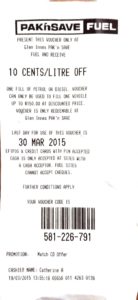
The supermarket petrol price mechanic has been around for sometime and is a simple customer proposition. Spend $x at a supermarket and receive y cents off your next fill of petrol at a pre defined Petrol Station Brand. I.e. Spend $200 dollars at Countdown and you get 20c off a litre at Z or Gull.
This is effectively a form of price discrimination (this is a pricing strategy that charges customers different prices for the same product or service). In this example a discount is applied to customers that have a docket and can be bothered in using the whereas those that can’t or don’t have a docket pay full price.
What’s in it for the customer: For the customer it is simple they receive a discount on fuel for (maybe) changing their shopping behaviour. Sometimes the savings are as ridiculously small as 6c a litre which is approx. 3% or $3.50 on a 50 litre top up. Hardly worth changing shopping behaviour however this works as petrol in NZ is a relatively inelastic product
What’s in it for the supermarket: This is a foot traffic driver especially when they have a large discount, they also use this mechanic to increase basket size. I would argue that the base savings are now just a hygiene factor.
What’s in it for the petrol station? This is a market share shift mechanism. Z’s CEO Mike Bennettsf has stated that he pays very little for the discount (approx. 2c not matter what the size is). And he gets the benefit of the supermarkets driving a change in purchasing behaviour to obtain the benefit.
I was recently driving through a small rural town that had two petrol stations, a Gull self service station and a Z full serve station. The price difference was very extreme and Z was using price discrimination to differentiate between customers and therefore grow margin at the expense of volume. In the town Gull was selling diesel for $1.09c per litre and Z had it at $1.21c. At first glance you would ask why any rational person would shop at Z, however Z have probably come to the following conclusions.
- We can’t compete on price with Gull, and there will be a natural differentiation between customers that want self service and full service
- Even if we get close to the Gull price, price sensitive customers will still choose the self service option, we would giving away margin for not additional volume
- Once the customers have segmented themselves, they only have one choice and that is us,
- Therefore we should charge the maximum price possible
Key Takeaways:
Price Discrimination is a valid method of managing margin and only discounting to customers that want a discount. Ideally we should price at the maximum that customers are willing to pay.
Small Discounts: Even small discounts (in this case 3%) on inelastic goods if packaged correctly can change customers behaviours and offer a much higher perceived value





